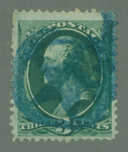
1873 3c green George Washington, used, with fancy star cancel and very fine centering. Stamp has secret mark added by Continental Bank Note Company - lower part of ribbon at left bottom of numeral "3" is heavily shaded.
Bank Note Series
March 1, 1870, is the earliest known use of one of the Bank Note stamps, a long-running set of stamps produced by three different bank note companies.
Less than a year earlier, in March 1869, the Post Office introduced the Pictorial Series. For the first time in US postal history, our stamps pictured something other than the portraits of national leaders.
Among the topics on the Pictorials were a train, a post rider, a ship, Christopher Columbus, and an eagle and shield. While these stamps are popular and sought after today, the people of the time thought the stamp designs were frivolous and the stamps themselves were very unpopular. Within a year, the stamps would be removed from sale.
The postmaster general then needed to develop new stamps to replace the Pictorials. Among the public’s many complaints were that the stamps were too small, unattractive, and of inferior quality. Thus, the new issues were not only larger and better quality, but they also carried new designs. Heads, in profile, of famous deceased Americans were chosen as the new subject matter.
Because the pictorials were to be printed for four years but were withdrawn from sale after less than a year, the National Bank Note Company still had three years remaining in their contract. They would be the first of the three Bank Note Companies to produce this new era of stamps. All of the stamps they produced were supposed to have grills, but only about five to ten percent had them.
The first known use of one of these new stamps, US #147, came on March 1, 1870. Several stamps of other denominations throughout March and April soon followed it.
This marked the start of the “Bank Note†Series, so named because it was printed by three prominent Bank Note printing companies – the National, Continental, and American Bank Note Companies, in that order. As the contract for printing passed from company to company, so did the dies and plates. Each company printed the stamps with slight variations, and identifying them can be both challenging and complex.
In 1873, new bids were submitted and a new contract was awarded to the Continental Bank Note Company. National was required to turn over their dies to Continental, but before they did, they placed small marks on each of them, “canceling†the dies. Also known as â€secret marks,†they were small, minor design changes that would help to distinguish the stamps printed by Continental from those printed by National.
The American Bank Note Company acquired Continental in 1879 and assumed the contract Continental had held. This firm, however, printed the stamps on a soft paper, which has different qualities than the hard paper used by the previous companies. While some of the stamps printed during this period used the same plates with secret marks, some stamps were also re-engraved.
Beginning in 1890, the Bank Notes underwent another significant change. New stamps issued from then until 1893 were at a smaller size. Because of this stamps from the earlier era (1870-1890) are referred to as “Large Bank Notes,†and stamps from 1890-94 are called “Small Bank Notes.†These smaller stamps were nearly square and their decreased size helped to cut costs.
The Bank Notes are an interesting area of collecting for their different shades of color and secret marks. They were also issued in an era when fancy cancels were in wide use, so you can often find these stamps with interesting and sometimes intricate cancellations. Bank Note proofs are also available. Some are more affordable than the issued stamps and are known for their clear, sharp impressions.
The Bank Note era officially came to an end on June 9, 1894, after the Post Office reached an agreement with the Bureau of Engraving and Printing to start producing new US stamps.
Click here to view all of the Bank Note stamps.










